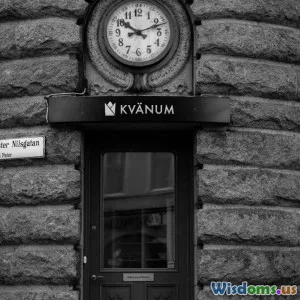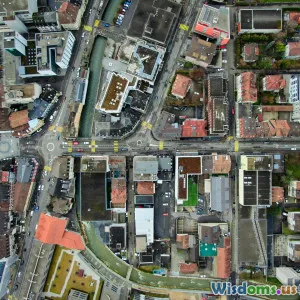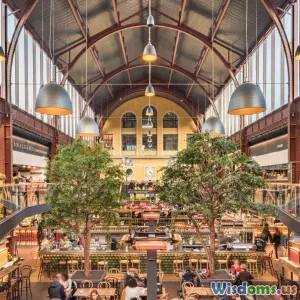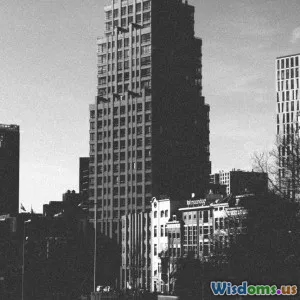
Exploring the 15 Minute City Concept
9 min read Discover how the 15 Minute City reshapes urban living by fostering accessibility, sustainability, and community within walking distances. (0 Reviews)
Exploring the 15 Minute City Concept: A New Paradigm in Urban Design
Introduction: Rethinking Urban Living
Imagine a city where everything you need—workplaces, schools, parks, healthcare, shops, and cafes—is reachable within a 15-minute walk or bike ride from your home. No long commutes, no daily rush hour chaos, and no reliance on cars for everyday errands. This is the heart of the 15 Minute City concept, a visionary framework already influencing architects, planners, and policymakers worldwide. It promises not just convenience but also healthier lifestyles, environmental benefits, and social cohesion.
As cities face growing populations, climate challenges, and increasing social fragmentation, the 15 Minute City emerges as a compelling response. But beyond its appealing simplicity lies a complex interplay of urban design principles, economic realities, and community engagement. This article unwraps the concept in depth, exploring its benefits, obstacles, and inspiring real-world examples.
What is the 15 Minute City?
The 15 Minute City is an urban planning model aimed at creating neighborhoods where residents can satisfy most of their daily needs within a quarter-hour journey on foot or bike. This means accessibility to four core pillars: living, working, supplying, and caring.
Origins: The term gained traction after Carlos Moreno, a French-Colombian scientist and urbanist, popularized the concept. Moreno stresses that urban life quality can be drastically improved by decentralizing city functions, creating 'complete neighborhoods' that reduce dependence on cars.
Key Principles:
- Proximity: Services and amenities must be close enough to walk or bike.
- Diversity: A mix of commercial, public, and green spaces.
- Density: Urban density supports viable local economies.
- Digital Connectivity: Smart technologies aid mobility and resource management.
This design balances urban vibrancy with accessibility ensuring that community members are not isolated by distance or transport barriers.
Why the 15 Minute City Matters: Benefits Explored
1. Environmental Sustainability
Transportation contributes roughly 29% of global greenhouse gas emissions (EPA, 2021). The 15 Minute City reduces the need for cars, lowering carbon footprints and air pollution. Cities like Paris have seen reductions in traffic and emissions by closing streets to vehicles and prioritizing bikes.
2. Public Health and Wellbeing
Walkable communities encourage physical activity, combating sedentary lifestyles linked to heart disease and obesity. The concept also enhances mental health by fostering social connections, green space access, and reducing daily stress from commutes.
Example: Melbourne's post-COVID plan places a strong emphasis on 20-minute neighborhoods, enhancing local walkability and access to mental health resources.
3. Economic Resilience
Smaller, diversified local economies flourish when residents support nearby businesses. This resilience proved critical during lockdowns when shopping locally remained essential. Furthermore, shorter trips mean time savings, which can be reinvested in productive or leisure activities.
4. Social Equity and Inclusion
Equitable access to education, healthcare, and services combats socio-economic disparities. The 15 Minute City aims to democratize urban amenities across different demographic groups, reducing spatial segregation.
Jane Jacobs, the legendary urbanist, stressed the value of mixed-use, community-centric neighborhoods decades ago—showing this isn’t just a new idea but a reinvention guided by current urgency.
Challenges and Criticisms
While inspiring, the 15 Minute City concept faces notable obstacles:
- Urban Sprawl and Infrastructure Limitations
Many cities grew episodically with car reliance deeply embedded. Retrofitting sprawling suburbs or poorly planned areas to fit 15-minute criteria demands massive investment.
- Gentrification Risks
Focusing development and amenities in certain neighborhoods without careful policy can drive up housing costs, pushing low-income residents out.
- Economic Viability and Employment
Some jobs inherently require centralized infrastructure or specialized facilities. Balancing decentralization without harming industries remains complex.
- Political and Cultural Barriers
Changing longtime travel habits and adapting zoning laws requires significant political will and citizen buy-in.
Despite these hurdles, numerous cities have begun pioneering policies to confront these challenges head-on.
Real-World Applications: Cities Leading the Way
Paris, France
Mayor Anne Hidalgo championed the 15 Minute City, embedding it in Paris’s climate strategy. The city invested heavily in bike lanes, pedestrian zones, and distributed public services. Reduced car zones led to significant drops in air pollution; a 27% reduction in nitrogen dioxide was recorded in the first year (AirParif, 2020).
Melbourne, Australia
The “20-minute neighborhood” strategy is a scaled adaptation of the concept, implemented during COVID-19 recovery. Melbourne's urban planners focused on enhancing local accessibility by expanding parks, local businesses, and promoting active transport.
Portland, Oregon, USA
Portland’s long-standing embrace of mixed-use zoning aligns well with the 15 Minute City ethos. Its focus on transit-oriented development and ridership growth prioritizes creating accessible neighborhoods free from car dependency.
How Architectural and Urban Designers Contribute
Architects play a pivotal role by designing mixed-use buildings, integrating residential, commercial, and public functions seamlessly. Urban designers influence zoning laws, streetscape design, and public realm enhancements encouraging pedestrian movement.
Design strategies include:
- Human-centered streetscapes: Prioritizing walkability with shaded sidewalks, benches, and art.
- Green corridors and pocket parks: Enhancing urban biodiversity and residents’ health.
- Adaptive reuse of buildings: Preserving heritage while meeting contemporary needs.
The collaboration between architects, city planners, transport engineers, and residents is critical to realize these living neighborhoods.
Conclusion: Towards a Human-Centered Urban Future
The 15 Minute City concept is more than an urban planning trend—it is a transformative vision aimed at restoring balance between people, places, and the planet. By shortening distances and prioritizing accessibility, it addresses urgent challenges like climate change, public health crises, and social inequities.
Cities worldwide are already illustrating the concept’s feasibility and broad benefits, but its success hinges on inclusive policy, thoughtful design, and community engagement. For residents, policymakers, and professionals alike, embracing the 15 Minute City offers a pathway to more livable, sustainable, and vibrant urban environments.
As urban dwellers, the challenge and opportunity lie in reimagining how we move, live, and connect with our neighborhoods—because the future of cities could be just a 15-minute walk away.
References
- U.S. Environmental Protection Agency (2021). Sources of Greenhouse Gas Emissions.
- AirParif Monitoring Reports (2020) — Paris Air Quality Changes.
- Moreno, C. (2020). The 15-Minute City.
- Jacobs, J. (1961). The Death and Life of Great American Cities.
- City of Melbourne (2021). 20-Minute Neighbourhood Policy.
- Portland Bureau of Planning and Sustainability.
Rate the Post
User Reviews
Popular Posts




















